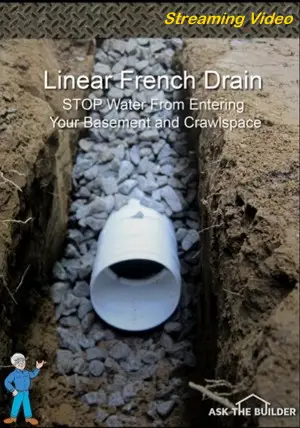Improve Yard Drainage
Old Man Winter finally got up and went home. This past year, he reminded me of that family relative that still is sitting on my couch at 10 pm on Thanksgiving, not knowing it was time to leave a while ago.
With warm temperatures and favorable weather here, it's time to get started on some spring projects. I surveyed my giant weekly newsletter list and discovered the top three projects they want help with. My guess is you have the exact same problems and could use some expert guidance. Let's get started!
Below is the first of the three projects. The links to the other articles are:
Repair Crumbling Concrete
How to Repair Damage to Hardwood Floors
Improve Drainage Around Homes
This was the top project nagging at my subscribers. Many suffer from wet basements, crawlspaces and soggy yards. If your yard has some slope to it, let's say about 3 feet of fall from the highest spot to the lowest spot, you can often get great relief with not too much work.
My college degree was in geology and I had a special interest in hydro-geology which concentrates on ground water. What I discovered is that in locations that have clay-rich soils, ground water tends to flow sideways through the top soil and on top of the dense clay subsoil.
This means you can install a linear french drain around your house that acts like an underground gutter. This trench only needs to be 6 inches wide and about 2 feet deep. You put about 2 inches of clean rounded gravel in the bottom of the trench. The gravel ranges in size from a marble to a walnut. It should be washed meaning there's no sand or fines in the gavel - just the different-sized stones.
You then put a perforated 4-inch drain tile on top of the gravel and fill the trench with the rounded gravel to within about 3 inches of the grass. Water flowing through the soil towards your home falls through the gravel down to the drain pipe. The water would rather flow through this pipe, the path of least resistance, than force its way through the soil.
The bottom of the trench should be level and it needs to extend to the lowest part of your lot where eventually the bottom of the trench will extend out to daylight. As the ground falls away, the trench becomes more shallow until the end of the pipe sticks out of the ground.
Water that flows down through the gravel pulls water out of the soil and this same system can be used to drain soggy back or front yards.
Be sure that your roof water is piped to the lowest part of your lot too. Don't allow it to flow onto the ground next to your home. Step-by-step directions of how to install a linear french drain can be found in a streaming video I produced years ago.
